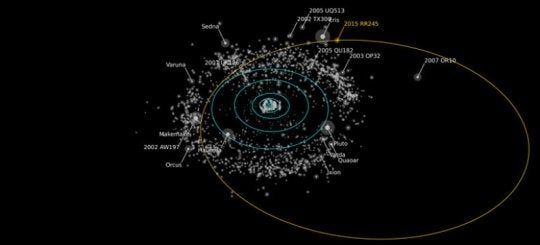The term dwarf planet has been both praised and criticized by astronomers as it began a new classification for objects in our solar system, but also “demoting” Pluto’s status.
Since its adoption in 2006, there are officially five dwarf planets (with around 100 or more in the Kuiper Belt alone waiting to be made official) recognized by the International Astronomical Union (IAU), but according to a new study, there’s one another to add to this long list.
Using the Canada-France-Hawaii-Telescope (CFHT) as part of the ongoing Outer Solar System Origins Survey (OSSOS), a team of astronomers have found a new dwarf planet orbiting beyond Neptune. Designated 2015 RR245 by the IAU’s Minor Planet Center, the dwarf planet is approximately 700 kilometers (435 miles) in size and has one of the widest orbits among the dwarf planets. It was first sighted in February of 2016 by Dr. JJ Kavelaars using OSSOS images from September 2015.
“These images [taken by the CFHT] were taken in such a way that you can see the motion of the object in the sky,” says Michele Bannister, a postdoctoral fellow with the OSSOS at the University of Victoria. “That allows us to detect those objects as they move relative to the background stars.”
RR245’s orbit takes it nearly 120 times further from the sun than Earth and 700 years to make a complete orbit. At 12 billion km (80 astronomical units, AU), RR245 is getting closer to closest approach at 5 billion km (34 AU) which will be around the year 2096. It has also been on a very elliptical orbit for the last 100 million years.
“Their [ the dwarf planets] present orbits are not where they formed, their orbits changed since the formation of the solar system,” says Bannister. “So their current orbits, which are much more eccentric, are signatures that Neptune has migrated.”
As this dwarf planet has only been studied for one out of its 700 year orbit, determining its specific orbit will be conducted over the next few years after which is can then be named. The OSSOS team can provide a name to be considered for the dwarf planet to the IAU.
Normally the OSSOS team works on finding new trans-Neptunian objects, or objects that orbit the sun at a greater distance than Neptune.
“We are looking at the structure of the outer solar system to understand the formation and evolution of the solar system,” says Bannister. “We are trying to tell what history the solar system had.”
The team is hoping to continue their research on trans-Neptunian objects as well as dwarf planet RR245.
“We will be investigating it with larger telescopes to measure its physical properties and understand its composition,” says Bannister.
Most other large dwarf planets have already been surveyed, so it is unlikely another object, such as RR245, will be found again until much larger telescopes, like the Large Synoptic Survey Telescope, become available in the 2020s.










